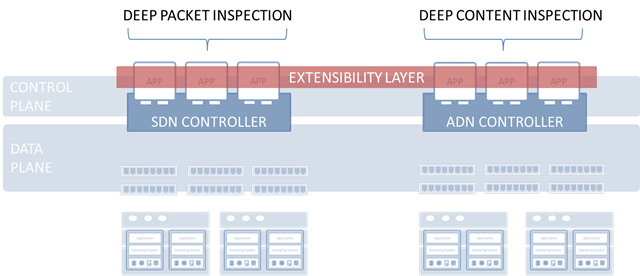admin wrote this on 18 Dec 2012
The increasing use of HTML5 Web Sockets illustrates one of the lesser mentioned value propositions of SDN – and ADN: extensibility. It’s likely that IT network and security staff would agree that HTML5 Web Sockets has the potential for high levels of disruptions (and arguments) across the data center. Developers want to leverage the ability to define their own protocols while reaping the benefits of the HTTP-as-application-transport paradigm. Doing so, however, introduces security risks and network challenges as never-before-seen protocols start streaming through firewalls, load balancers, caches and other network-hosted intermediaries that IT network and security pros are likely to balk at. Usually because they’re the last to know, and by the time they do – it’s already too late to raise objections.
Aside from the obvious “you folks need to talk more” (because that’s always been the answer and as of yet has failed to actually occur) there are other answers. Perhaps not turn-key, perhaps not easy, but there are other answers. One of them points to a rarely discussed benefit of SDN that has long been true for ADN but is often overlooked: extensibility through programmability.
The ability to alter behavior of any network component in real-time, to make what has been traditionally static dynamic enough to adapt to changing conditions is the goal of many modern technology innovations including SDN (the network) and cloud computing (applications and services). When developers and vendors can create and deploy new protocols and toss them over the wall into a production environment, operations needs the ability to adapt the network and delivery infrastructure to ensure the continued enforcement of security policies as well as provide support to assure availability and performance expectations are met. Doing so requires extensibility in the network. Ultimately that means programmability.
EXTENSIBILITY through PROGRAMMABILITY

While most of the networking world is focused on OpenFlow and VXLAN and NVGRE and virtual network gateways, the value of the ability to extend SDN through applications seems to be grossly underestimated. The premise of SDN is that the controller’s functionality can be extended through specific applications that provide for handling of new protocols, provide new methods of managing flows, and do other nifty things that likely only network geeks would truly appreciate.
The ability to extend packet processing and add new functions or support for new protocols rapidly, through software, is a significant part of the value proposition of SDN. Likewise, it illustrates the value of the same capabilities that currently exist in ADN solutions.
ADN, too, enables extensibility through programmability. While varying degrees of control and capabilities exist across the ADN spectrum, at least some provide complete programmatic control over traffic management by offering the ability to “plug-in” applications (of a sort) that provide support for application-specific handling or new (and often proprietary) protocols, like those used to exchange data over Web Sockets-transported connections.
What both afford is the ability to extend the functionality of the network (SDN) or application traffic management (ADN) without requiring upgrades or new products. This has been a significant source of value for organizations with respect to security, which often turn to the ADN solutions topologically positioned in a strategic point of control within the network to address zero-day or emerging exploits for which there are no quick fixes.
When it comes to something like dealing with custom (proprietary) application protocols and the use of Web Sockets, for which network infrastructure services naturally has no support, the extensibility of SDN and ADN are a boon to network and security staff looking for ways in which to secure and address operational risk associated with new and heretofore unknown protocols.
Visit us at Neevtech.com to know more about our offerings.
Tags: ADN, extensibility, HTML5, Networks, programmability, SDN
© 2013 Blog | Neev Technologies
Leave a Comment